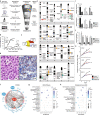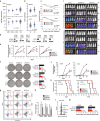WDR26 and MTF2 are therapeutic targets in multiple myeloma
- PMID: 34876184
- PMCID: PMC8650373
- DOI: 10.1186/s13045-021-01217-9
WDR26 and MTF2 are therapeutic targets in multiple myeloma
Abstract
Unbiased genetic forward screening using retroviral insertional mutagenesis in a genetically engineered mouse model of human multiple myeloma may further our understanding of the genetic pathways that govern neoplastic plasma cell development. To evaluate this hypothesis, we performed a tumor induction study in MYC-transgenic mice infected as neonates with the Moloney-derived murine leukemia virus, MOL4070LTR. Next-generation DNA sequencing of proviral genomic integration sites yielded rank-ordered candidate tumor progression genes that accelerated plasma cell neoplasia in mice. Rigorous clinical and biological validation of these genes led to the discovery of two novel myeloma genes: WDR26 (WD repeat-containing protein 26) and MTF2 (metal response element binding transcription factor 2). WDR26, a core component of the carboxy-terminal to LisH (CTLH) complex, is overexpressed or mutated in solid cancers. MTF2, an ancillary subunit of the polycomb repressive complex 2 (PRC2), is a close functional relative of PHD finger protein 19 (PHF19) which is currently emerging as an important driver of myeloma. These findings underline the utility of genetic forward screens in mice for uncovering novel blood cancer genes and suggest that WDR26-CTLH and MTF2-PRC2 are promising molecular targets for new approaches to myeloma treatment and prevention.
Keywords: Carboxy-terminal to LisH (CTLH) complex; Forward genetic screen; Moloney murine leukemia virus; Plasma cell neoplasia; Polycomb repressive complex 2 (PRC2).
© 2021. The Author(s).
Conflict of interest statement
The authors declare no conflict of interest.
Figures


Similar articles
-
Polycomb-like Proteins in Gene Regulation and Cancer.Genes (Basel). 2023 Apr 18;14(4):938. doi: 10.3390/genes14040938. Genes (Basel). 2023. PMID: 37107696 Free PMC article. Review.
-
Tissue-Specific Tumour Suppressor and Oncogenic Activities of the Polycomb-like Protein MTF2.Genes (Basel). 2023 Sep 27;14(10):1879. doi: 10.3390/genes14101879. Genes (Basel). 2023. PMID: 37895228 Free PMC article. Review.
-
MTF2 recruits Polycomb Repressive Complex 2 by helical-shape-selective DNA binding.Nat Genet. 2018 Jul;50(7):1002-1010. doi: 10.1038/s41588-018-0134-8. Epub 2018 May 28. Nat Genet. 2018. PMID: 29808031
-
PHF19 promotes multiple myeloma tumorigenicity through PRC2 activation and broad H3K27me3 domain formation.Blood. 2019 Oct 3;134(14):1176-1189. doi: 10.1182/blood.2019000578. Epub 2019 Aug 5. Blood. 2019. PMID: 31383640 Free PMC article.
-
PRC2 targeting is a therapeutic strategy for EZ score defined high-risk multiple myeloma patients and overcome resistance to IMiDs.Clin Epigenetics. 2018 Oct 3;10(1):121. doi: 10.1186/s13148-018-0554-4. Clin Epigenetics. 2018. PMID: 30285865 Free PMC article.
Cited by
-
Polycomb-like Proteins in Gene Regulation and Cancer.Genes (Basel). 2023 Apr 18;14(4):938. doi: 10.3390/genes14040938. Genes (Basel). 2023. PMID: 37107696 Free PMC article. Review.
-
Graphdiyne biomaterials: from characterization to properties and applications.J Nanobiotechnology. 2025 Mar 4;23(1):169. doi: 10.1186/s12951-025-03227-y. J Nanobiotechnology. 2025. PMID: 40038692 Free PMC article. Review.
-
Extracellular vesicles as therapeutic modulators of neuroinflammation in Alzheimer's disease: a focus on signaling mechanisms.J Neuroinflammation. 2025 Apr 25;22(1):120. doi: 10.1186/s12974-025-03443-1. J Neuroinflammation. 2025. PMID: 40281600 Free PMC article. Review.
-
Comprehensive characteristics of pathological subtypes in testicular germ cell tumor: Gene expression, mutation and alternative splicing.Front Immunol. 2023 Jan 13;13:1096494. doi: 10.3389/fimmu.2022.1096494. eCollection 2022. Front Immunol. 2023. PMID: 36713456 Free PMC article.
-
Tissue-Specific Tumour Suppressor and Oncogenic Activities of the Polycomb-like Protein MTF2.Genes (Basel). 2023 Sep 27;14(10):1879. doi: 10.3390/genes14101879. Genes (Basel). 2023. PMID: 37895228 Free PMC article. Review.
References
-
- Duncan K, Rosean TR, Tompkins VS, Olivier A, Sompallae R, Zhan F, Tricot G, Acevedo MR, Ponto LL, Walsh SA, et al. (18)F-FDG-PET/CT imaging in an IL-6- and MYC-driven mouse model of human multiple myeloma affords objective evaluation of plasma cell tumor progression and therapeutic response to the proteasome inhibitor ixazomib. Blood Cancer J. 2013;3:e165. doi: 10.1038/bcj.2013.61. - DOI - PMC - PubMed
Publication types
MeSH terms
Substances
Grants and funding
LinkOut - more resources
Full Text Sources
Medical
Molecular Biology Databases

